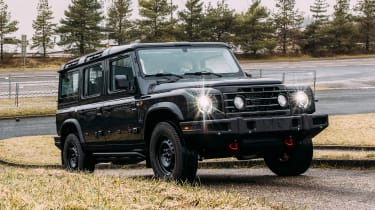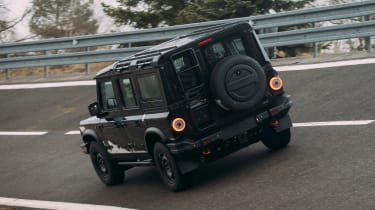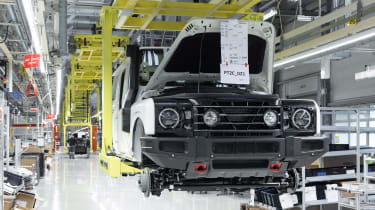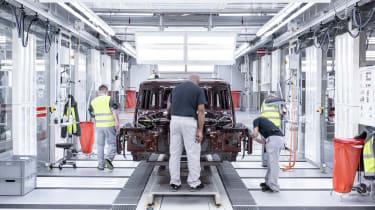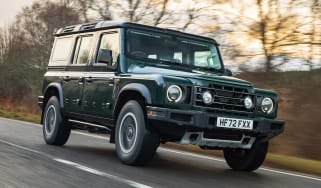Ineos Automotive trials Grenadier production at Hambach plant
Ineos Automotive is trialling the production process of its Grenadier off-roader by building over 100 prototypes, before full production commences later this year
Early-phase production has commenced for the Ineos Grenadier, the rugged 4x4 designed to fill the void left by the original Land Rover Defender when it was replaced in 2020. Ineos is now in the ‘production try out’ stage at its plant in Hambach, France, where it is building batches of prototype vehicles to finalise factory processes before full production begins in July. Customers will be able to place orders in April, when full pricing will be announced.
In 2020, Ineos Automotive decided to move the Grenadier’s production from a proposed facility in Wales to one in France - at the time, the move was branded a “no brainer” by the brand’s commercial director Mark Tennant, despite the fact that it scuppered 500 jobs for the UK’s post-Brexit motor industry.
Ineos originally planned to assemble the Grenadier in Wales, near Ford’s soon-to-be closed Bridgend plant. However, the firm instead took ownership of the Mercedes factory in Hambach - it’s handily close to the German border and allows for easy transport of the 4x4’s BMW mechanicals.
Before Ineos bought the factory, Mercedes’ parent company Daimler was due to close the Hambach plant, which only produces the Smart EQ ForTwo. However, the electric city car will now be built alongside the Grenadier in the same factory, with Daimler contracting the car’s production to Ineos. When Smart production ceases, Ineos will have access to more equipment and facilities to ramp up production of its 4x4.
Trial production run
Ineos has now begun building 130 prototype vehicles for its first production try-out phase, to hone the manufacturing process and iron out any missteps before building customer vehicles. The brand has taken around 15,000 reservations for the Grenadier so far, with customers able to finalise orders in April. The company has also nominated over 100 retail and service partners to handle sales and aftercare for the Grenadier.
Speaking on the production try-out, Mark Tennant said: “We need to get the vehicles to the customers at 100 per cent quality. We also need to be ready for problems - there will be problems, and we’re ready for that”.
The Grenadier is being manufactured on an adapted Smart production line, which spans 1,000 metres across four factory wings. The Hambach plant is said to be the first-ever carbon neutral car factory, and employs around 1,000 workers to build the Grenadier.
Since the Grenadier is significantly larger and heavier than the Smart, the carriers along the production line have been reinforced, as has the building itself. Due to the car’s body-on-frame construction, the Grenadier is built as a rolling chassis first, before being married up with its BMW-derived powerplant.
Mercedes had previously invested €470 million (around £395 million) into the factory, and Ineos has since pledged over €50 million (£42 million) – mainly to fund the upgraded production line and new body and paint facilities for its SUV. The company is also utilising robots that were originally intended to produce Mercedes EVs, which construct the body and frame of the car and use 600 measuring points to ensure that they are built to the nearest millimetre. For rust protection, wax is injected into the body of each Grenadier, and certain parts are e-coated to prevent corrosion.
At present, defective components are taken off the production line to be inspected by hand and using ultrasonic sensors, to identify mistakes in the process so they can be rectified for full production. Aside from robot maintenance, inspections and loading componentry, the entire body-building process is automated.
Switch from Wales to France
At the time, Tom Crotty, Ineos’s communications director, spoke to BBC Radio 5 about the company’s decision to move the Grenadier’s factory onto the continent. “We were looking to build in Wales and, in the meantime, we had an approach from Mercedes who we built a very good relationship with through Formula One – and who had a ready-made factory on the Franco-German border available to us.
“It’s almost brand new,” he said. “They were going to use it to build a 4x4, they changed their business position and therefore we had a very simple business decision. Do we want to take the risk of building our own factory or do we want to take one that Mercedes has already built and is ready to go? And that was a very simple business decision to make.
“That was the driver. We’ve heard a lot of stuff about how it was to with Brexit or all sorts of other things – but that’s absolute nonsense. It was to do with a very simple business decision. Someone is presenting you with a state-of-the-art, new factory that’s ready-built versus the risk of building your own.”
Crotty also commented on the comparably limited number of jobs the Welsh factory would have provided, compared to the rest of the Ineos’s operations. He said: “We would have employed 200 people in Wales. We currently employ 6,500 in the UK on our chemical plants – and we’ve just acquired BP’s business, which extends that by another 1,000 or so people. So, we think that we are providing huge numbers of high quality jobs [for the UK].”
Speaking with Auto Express, Tennant said that the company “understands” the adverse reaction from some UK commentators regarding the company’s decision, but revealed that taking on a pre-existing manufacturing facility was always an option under consideration.
“The commercial side of the argument that I think people will absolutely get is that the whole industry has been completely knocked sideways by what happened in 2020. The commercial benefit of buying an existing factory which has received recent investment, that is suited to the product we are producing with a highly skilled workforce already in place, it’s kind of a no-brainer to go down the road that we’ve gone,” he suggested.
“This allows us to get to the start line, irrespective of Covid in pretty much the same timetable as originally planned. That’s huge for us.”
Q&A - Mark Tennant, commercial director, Ineos Automotive
Can you explain the financial advantage of choosing Hambach over the Bridgend plan?
I think that the main advantage is to hit our timing plan. We had the original plan we were happy with pre-covid to build anew with the Bridgend plant, but the world changed in 2020. So a couple of things - from our side we were getting quite nervous about the ability to break ground and put the buildings up in time with the lockdowns in south Wales.
From Daimler’s side they clearly were having a rethink on their strategy for Hambach. We did look very extensively at using existing plant capacity in Europe and beyond earlier on in the project and couldn't find anything suitable. As a result of covid they had a rethink and it came up as a possibility.
So before any idea of Bridgend there was a search for a pre-existing factory to build the car in Europe?
Yeah we looked at and beyond Europe to be honest. We looked extensively - capacity is not in short supply in terms of existing manufacturing facilities, overcapacity has been a problem in the industry for a while. But we went for the choices we made because everything that was available was too big, too old, too much investment, nothing really worked. When Hambach came up as an opportunity, it had received considerable investment to accommodate a new electric SUV Mercedes was planning to build there, and therefore it suited us extremely well.
Could a deepening of the relationship with Daimler be possible?
It’s an ongoing relationship. We were a principal partner on the Mercedes-AMG F1 team so we know them well. But this is a deal which stands on its own feet and I can’t speculate on what happens in the future.
So no technology advantages for you in terms of the EV tech on site?
I think our focus is on making the most of Hambach generally. We are going to be contract manufacturing the Smart ForTwo for a while for Mercedes, and the focus is on delivering the best quality product that they rightly require in that time. From an alternative fuel point of view that’s clearly something we are looking at closely for Grenadier. You will know of the M.O.U we signed recently with Hyundai looking at fuel cells, and we’ve still got an open mind on what the long term future for alternative fuel techs might be.
How does the move to drop Bridgend and go for Hambach affect the image of the company?
I think that there’s an emotional and a commercial response. The emotional one I understand particularly with Brexit going on and the negatives around our decision not to go to Wales, and we were torn as well, as we were very happy with the plan we had.
The commercial side of the argument that I think people will absolutely get is that the whole industry has been completely knocked sideways by what happened in 2020 and the commercial benefits of buying an existing factory which has received recent investment, that is suited to the product we are producing with a highly skilled workforce already in place, it’s kind of a no-brainer to go down the road that we’ve gone. Above all else Ineos is a business and the owners are very commercially minded. This allows us to get to the start line with covid in pretty much the same timetable as originally planned. That’s huge for us.
Of course we are torn and we understand some of the emotional outpourings as a result of the decision.
What aspects of the Grenadier remain British?
Ineos already employs about 6,000 people in the UK, Ineos Automotive is a British company and we employ about 100 people - that’s increasing rapidly as we get closer to production and we expect to be doubling that number in the course of the next 12 to 18 months.
We are very proudly British but we are also pan-European. We have similar numbers in Germany, we have the engineering element being done by Magna in Austria, in spite of the fact we are no longer doing sub-assembly work in Portugal we have retained an office and people down there mostly on the logistics side.
So I think we can still speak quite passionately about Ineos being a British company, but equally as with every larger OEM the supply base is not parochial, it is across borders and we are no different to anybody whether they are doing general or final assembly in the UK or not.
Check out the latest on Britishvolt's plans for a UK gigafactory here...

